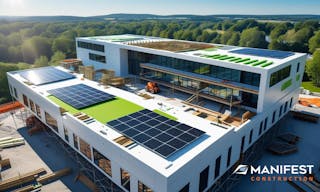
Sustainable Construction – Green Materials and Energy-Efficient Building Design
Sustainable construction has moved from niche to mainstream. The revised EU Energy Performance of Buildings Directive mandates zero-emission new builds from 2030, while the global green building market exceeded USD 640 billion in 2025 and continues to expand at almost 10% annually. Energy performance is now a core value driver, shaping finance, compliance and Facility Management strategies alike.

Every project begins with design decisions. Bioclimatic orientation, daylight harvesting and 7D BIM modelling simulate energy flows before ground-breaking, enabling Nearly Zero-Energy Buildings in Greece to operate with up to 70 % less consumption than code minimums. “Design for disassembly” keeps materials in the circular economy, lowering life-cycle costs and feeding future integrated facility services with reclaimable components.
Material innovation is pivotal. With cement responsible for roughly 8 % of global CO₂ emissions, architects are embracing cross-laminated timber for tall urban “plyscrapers”, structural stone from local quarries, rammed earth walls and insulation panels made from recycled coffee fibres. Environmental Product Declarations make such choices transparent for design teams and Facilities Management professionals who will later maintain the asset.
Operational efficiency is secured by smart-building technology. IoT sensors, smart meters and BMS platforms give Facility Management real-time insight to optimise HVAC, lighting and water usage. Predictive control algorithms routinely cut annual energy bills by 25-30 % and maintenance costs by 15 %, while boosting WELL scores and tenant satisfaction.
Sustainability does not end at hand-over. Today’s FM contracts embed SLAs for energy-use intensity, embodied-carbon KPIs, recycling ratios and employee well-being metrics. FM analytics dashboards merge these data streams, offering investors and occupiers a single source of truth. In this model the building becomes a living organism—continuously learning, adapting and improving across its life-cycle.
Companies that commit to green materials, circular design and data-driven operation position themselves ahead of regulation, unlock ESG financing and attract sustainability-minded talent and customers. Sustainable construction is no longer a cost premium; it is a strategic choice that delivers economic, environmental and social return.